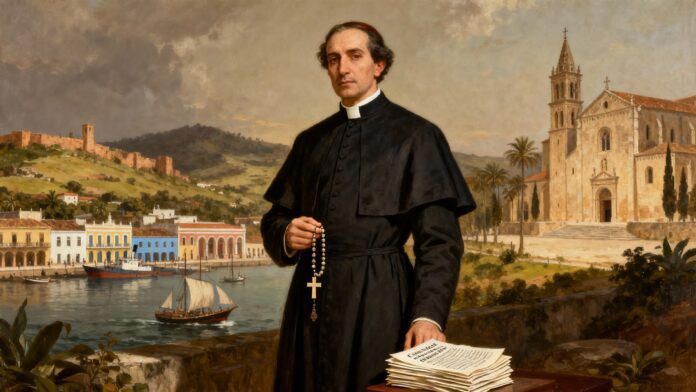Catalan born in 1807, weaver turned typographer then priest, Antoine-Marie Claret traveled Spain and Cuba, rosary in hand, distributing brochures and pious images. Founder of the Claretians in 1849, missionary archbishop in Santiago de Cuba, defender of slaves, confessor to Queen Isabella II, he escaped fifteen assassination attempts before dying in exile in 1870. A figure of social Catholicism and modern evangelization, he combined Marian contemplation, intrepid missionary action and innovative use of printing to bring the Word to the greatest number.
Distributing the printed Word, carrying the rosary, defending the oppressed: Antoine-Marie Claret embodies the 19th-century apostle, weaving links between tradition and modernity. Born in 1807 near Barcelona, he died in French exile in 1870, after founding a missionary congregation, governing a hostile Caribbean diocese, advising a queen, and participating in the First Vatican Council. His liturgical memorial, on October 24, invites us to combine apostolic boldness with Marian fidelity.

A weaver who became a universal missionary
Antoine-Marie Claret was born on December 23, 1807, in Sallent, a small Catalan town near Barcelona. The eldest son of a family of weavers, he learned his father's trade as a teenager. At 18, he left the family workshop for Barcelona, where he became a typographer in a printing house. This experience left a lasting impression on him: the press could disseminate the divine Word massively and quickly. He thus discovered his future mission.
In 1829, at the age of 22, he entered the Vicq seminary. Ordained a priest in 1835, he embarked on an itinerant preaching mission throughout Catalonia. Rosary in hand, he visited villages and hamlets, distributing holy images and brochures that he printed himself. His direct style and ardent sermons attracted crowds and conversions. He already dreamed of distant missions, but Providence traced an intermediate path for him.
In 1849, he founded the Congregation of the Missionary Sons of the Immaculate Heart of Mary, the Claretians, in Vicq. The institute combined intense apostolic life with deep Marian devotion. Claret wanted to train mobile preachers, printing and distributing spiritual works accessible to the people. By 1850, six communities had emerged in Catalonia.
That same year, Pope Pius IX appointed him Archbishop of Santiago de Cuba. Far from refusing this charge, which thwarted his missionary plans, Claret accepted it as divine will. In Cuba, he discovered a sleepy Church, a lax clergy, and a brutal slave society. He systematically visited isolated parishes and missions, traveling on foot or on horseback through the island's mountains. He preached tirelessly, distributed images and booklets, and multiplied the number of popular catechisms.
Above all, he publicly defended black slaves, denounced the abuses of slave owners, and condemned public immorality and widespread concubinage. These stances earned him fierce hatred. Between 1850 and 1857, fifteen attempts were made on his life. During the most serious, in 1856 in Holguin, a man injured his face with a razor. Claret survived, forgave his attacker, and continued his mission.
In 1857, Queen Isabella II of Spain recalled him to Madrid as confessor and spiritual advisor. He held this delicate position for eleven years, accompanying the sovereign on her travels, preaching at court, while remaining Superior General of the Claretians. In 1868, the Liberal Revolution expelled Isabella II. Claret followed her into exile in Paris. The Claretians were expelled from their Spanish homes and founded a community in Prades, in the Pyrénées-Orientales.
In 1869-1870, Claret actively participated in the First Vatican Council in Rome. He supported the definition of papal infallibility. Exhausted and ill, he retired to the Cistercian monastery of Fontfroide, near Narbonne. He died there on October 24, 1870, at the age of 62, far from his native Catalonia.

The apostle of the rosary and the fifteen attacks
Hagiographic tradition highlights three striking features. First, the rosary constantly worn on her wrist: Claret prayed while walking, visiting, and writing. This visible rosary embodied her total Marian devotion. Then, the fifteen assassination attempts in Cuba: a symbolic figure reported by her companions, illustrating the violent hostility aroused by her prophetic ministry. Finally, the proliferation of spiritual writings: more than 200 printed titles, brochures, pamphlets, and books are attributed to her.
Historically, records confirm at least three serious attempts on his life in Cuba, including the one in Holguin. The other references likely relate to threats, intimidation, or unsuccessful attempts. But the number fifteen, repeated since his beatification, structures his image as a bloodless martyr, a persecuted apostle for social justice and moral reform.
The legend of the indestructible rosary accompanies his memory: worn out by continual prayer, it miraculously renewed itself. An edifying tale rather than a verifiable fact, it signifies incessant prayer, constant intimacy with Mary. Claret himself wrote that union with God came through the intense love of Christ and the life of Marian prayer.
His legacy extends beyond Spain. The Claretians spread throughout Latin America, Africa, and Asia. Beatified in 1934 and canonized in 1950, Anthony Mary Claret inspires today all missionary pastoral work combining contemplation, social action, and the use of modern media to evangelize. He prefigures the Catholic commitment to human rights and the dignity of the poor, central themes of the post-conciliar social magisterium.
Spiritual message
Antoine-Marie Claret teaches apostolic boldness rooted in Marian prayer. His life unites silent contemplation and risky public action, intimacy with Christ and defense of the oppressed.
It reminds us that authentic evangelization disturbs, shakes up, and provokes resistance. The rosary on the wrist symbolizes the inner source that supports external commitment.
His words still resonate: “The best disposition for union with God is intimacy with Our Lord and a life of love.”
Concretely, this means praying daily, acting justly, communicating the faith by all available means.
Claret invites us to combine deep spiritual fidelity and courageous apostolic creativity, without giving in to either sterile activism or comfortable passivity.
Prayer
Saint Anthony Mary Claret, apostle of the rosary and of justice, grant us your missionary flame.
Give us the boldness to defend the oppressed, perseverance in the face of obstacles, and creativity to communicate the Gospel today.
Like you, may we draw strength from daily intimacy with Christ and Mary.
Help us to combine deep prayer and courageous action, Marian contemplation and service to the poor.
May your example inspire our fidelity in trials, our forgiveness towards our adversaries, our unfailing hope in Providence.
Through your intercession, may the Church radiate the love of the Immaculate Heart of Mary.
Amen.
To live
- Pray a complete rosary, meditating on the union between contemplation and missionary action, entrusting a situation of injustice observed.
- Disseminate spiritual content through modern means (social network, message, article) that nourishes the faith of others simply and concretely.
- Consider for ten minutes a situation where defending justice requires courage, asking for the intercession of Saint Anthony Mary for the necessary boldness.
Memory
The body of Saint Anthony Mary Claret rests in Vicq, Catalonia, the city of his Claretian foundation. The Cistercian monastery of Fontfroide, near Narbonne, preserves the cell where he died in exile on October 24, 1870. A memorial chapel there honors his memory. The Claretian community of Prades, in the Pyrénées-Orientales, perpetuates the French connection since his final year. In Santiago de Cuba, the cathedral and several rural shrines commemorate his bold missionary episcopate.
In Catalonia, Sallent, his native village, houses a Claretian museum displaying personal belongings, autograph writings, and iconography. Barcelona preserves sites of his formation. The Claretians maintain mission houses in more than 60 countries, spreading the Marian spirituality and social commitment inherited from the founder. His liturgical feast, set on October 24, brings together Claretian communities, devout faithful, and admirers of his apostolic audacity.
Liturgy
- Readings and Psalm: Romans 8:26-30 on the Spirit's intercession and the divine call; Psalm 33 on the Lord's protection for his servants; Matthew 9:35-38 on the abundant harvest and missionary workers.
- Song or hymn: “O Mary conceived without sin” or a Marian canticle evoking the Immaculate Heart of Mary, patroness of the Claretians and spiritual source of their founder.



